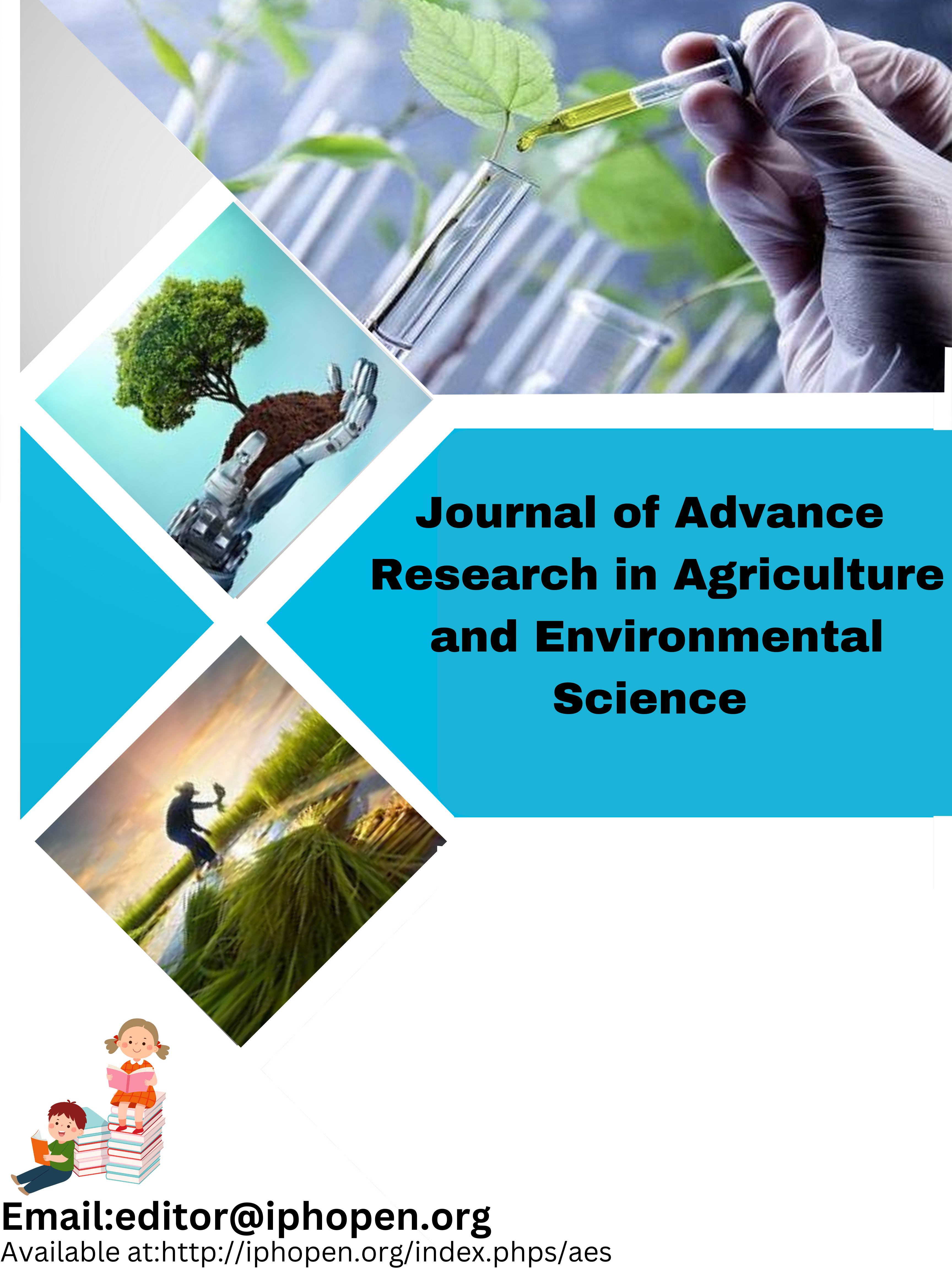EVALUATION OF CARBON DIOXIDE EMISSIONS IN SOIL UNDER DIFFERENT REDOX POTENTIALS
EVALUATION OF CARBON DIOXIDE EMISSIONS IN SOIL UNDER DIFFERENT REDOX POTENTIALS
DOI:
https://doi.org/10.5281/zenodo.15070219Keywords:
CO2 emission, greenhouse gas, redox potential, oxidized, reducedAbstract
Carbon dioxide (CO2) is a major greenhouse gas (GHG) contributing about 60% to the total GHGs in the atmosphere. According to statistics, 70% of the earth soils are waterlogged soil (reduce condition) which has effect on CO2 fluxes. Hence, the experiment set out is to investigate how CO2 is being emitted under different soil redox potential. Three locations were used for the study. The sites were categorized into Oxidized soil (Eh> 300), moderately reduced soil (-100 to 300) and reduced soil (redox Eh< - 100). Data collected included the emissions of CO2 on each of the redox statuses. CO2 emission was monitored using gas entrapment method and it was done in the morning, afternoon and evening. Also cumulative trapping was done for 24 hours. Graph and bar chart were generated using Microsoft excel 2016 to present results. The result showed that the emission of CO2 is highest under Oxidized soil and low in moderately reduced soil and reduced soil. Also emission was found to be highest in the afternoon compared to other times of the day. It was concluded that there is emission of CO2 in the three locations however; Oxidized soil has the highest emission of carbon dioxide.
References
Batjes N.H. (2014). Total carbon and nitrogen in the soils of the world. European Journal of Soil Science,
(1), 10-21.
Blagodatskaya E, and Kuzyakov Y. (2008). Mechanisms of real and apparent priming effects and their
dependence on soil microbial biomass and community structure: critical review. Biology and Fertility of
Soils. 45(2), 115-131.
Canadell, J. G., Le Quéré, C., Raupach, M. R., Field, C. B., Buitenhuis, E. T., Ciais, P., and Marland, G.
(2007). Contributions to accelerating atmospheric CO2 growth from economic activity, carbon intensity, and
efficiency of natural sinks. Proceedings of the National Academy of Sciences, 104(47), 18866-18870.
Davidson E.A., and Janssens I.A. (2006). Temperature sensitivity of soil carbon decomposition and
feedbacks to climate change. Nature, 440(7081), 165-173.
Dayo-Olagbende G. O., Adejoro S. A., Ewulo B. S., and Awodun M. A. (2020). Effects of
Oxidation-Reduction Potentials on Soil Microbes. Agricultura Scientia, 16(1-2), 35-42.
https://doi.org/10.18690/agricultura.16.1-2.35-42.2019
Delgado-Baquerizo M, Maestre FT, Escolar C. (2014). Direct and indirect impacts of climate change on
microbial and biocrust communities alter the resistance of the N cycle in a semiarid grassland. Journal of
Ecology, 102(6), 1592-1605.
Fierer, N., and Schimel, J. P. (2003). A proposed mechanism for the pulse in carbon dioxide production
commonly observed following the rapid rewetting of a dry soil. Soil Science Society of America Journal,
(3), 798-805.
Houghton, R.A. (2003). "Revised estimates of the annual net flux of carbon to the atmosphere from changes
in land use and land management 1850-2000." Tellus B: Chemical and Physical Meteorology, 55(2), 378-
IPCC (2014). Climate Change 2014: Synthesis Report. Contribution of Working Groups I, II and III to the
Fifth Assessment Report of the Intergovernmental Panel on Climate Change [Core Writing Team, R.K.
Pachauri, and L.A. Meyer (Eds.)]. IPCC.
Jobbágy, E.G., and Jackson, R.B. (2000). "The vertical distribution of soil organic carbon and its relation to
climate and vegetation." Ecological Applications, 10(2), 423-436.
Keeling, C.D., and Whorf, T.P. (2005). "Atmospheric CO2 Concentrations (ppmv) Derived from In Situ Air
Samples Collected at Mauna Loa Observatory, Hawaii." Carbon Dioxide
Knorr KH, Blodau C. (2009). Impact of experimental drought and rewetting on redox transformations and
methanogenesis in mesocosms of a northern fen soil. Soil Biology and Biochemistry, 41(6), 1187-1198.
Le Quéré, C., Andrew, R. M., Friedlingstein, P., Sitch, S., Hauck, J., Pongratz, J., ... & Korsbakken, J. I.
(2018). Global Carbon Budget 2017. Earth System Science Data, 10(1), 405-448.
Luo, Y., Wan, S., Hui, D., & Wallace, L. (2001). Acclimatization of soil respiration to warming in a tall
grass prairie. Nature, 413(6856), 622-625.
Monika, R., Shalin, S., and Pathak, H. (2002). "Effect of soil management on methane emission and grain
yield from a rice field in India." Nutrient Cycling in Agroecosystems, 63(2-3), 155-162.
Paustian, K., Lehmann, J., Ogle, S., Reay, D., Robertson, G. P., & Smith, P. (2016). Climate-smart soils.
Nature, 532(7597), 49-57.
Sinsabaugh, R. L., Manzoni, S., Moorhead, D. L., and Richter, A., (2013) Carbon use efficiency of microbial
communities: stoichiometry, methodology and modelling.. Ecology Letters, 16(7), 930-939.
Ström, L, Ekblad. A, and Näsholm T. (2003). Microbial biomass measured as total lipid phosphate in soils of
different organic content. Journal of Microbiological Methods, 54(1), 89-93.
Subke, J.A., and Bahn, M. (2010). "On the 'Temperature Sensitivity' of Soil Respiration: Can We Use the
Arrhenius Equation as a Common Function for Constructing a Multi-Model Ensemble?" Biogeochemistry,
(1-3), 39-43.
Wang Z, Shen W, and Zhao X, et al. (2010). The response of soil respiration to simulated warming in an
alpine meadow on the Tibetan Plateau. PLoS ONE, 5(3), e10119.
Downloads
Published
How to Cite
Issue
Section
License
Copyright (c) 2025 IPHO-Journal of Advance Research in Agriculture and Environmental Science

This work is licensed under a Creative Commons Attribution-NonCommercial-ShareAlike 4.0 International License.
Author(s) and co-author(s) jointly and severally represent and warrant that the Article is original with the author(s) and does not infringe any copyright or violate any other right of any third parties and that the Article has not been published elsewhere. Author(s) agree to the terms that the IPHO Journal will have the full right to remove the published article on any misconduct found in the published article.











